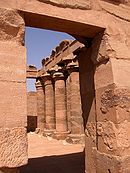- New Wadi es-Sebua
-
The site of New Wadi es-Sabua, which is located only 4 km west from the original site of Wadi es-Sebua, is today home to three Ancient Egyptian temples in Lower Nubia, the temples of Wadi-es Sebua, Maharraqa and Dakka respectively.[1]
Contents
Wadi es-Sabua Temple
The Temples of Wadi es-Sebua were created by two New Kingdom Egyptian pharaohs under Ramesses II and Amenhotep III respectively. Both temples feature pylons and an inner rock-cut sanctuary. The structures were subsequently moved to a new location in the 1960's due to the construction of the Aswan Dam
Temple of Maharraqa
The temple of Maharraqa was an Ancient Egyptian Roman period temple that was never completed.
Temple of Dakka
The Greco-Roman Temple of Dakka, dedicated to Thoth, is today located at the New Wadi es-Sebua area.
References
- ^ Christine Hobson, Exploring the World of the Pharaohs: A complete guide to Ancient Egypt, Thames & Hudson 1993 paperback, p.1177
Categories:- Archaeological sites in Egypt
Wikimedia Foundation. 2010.


